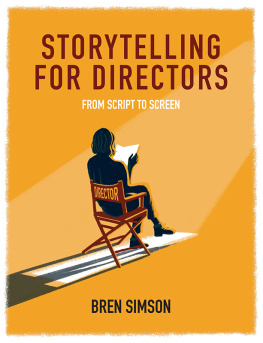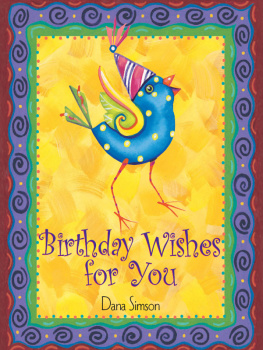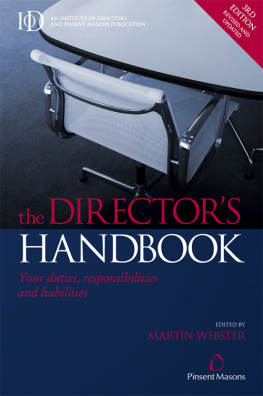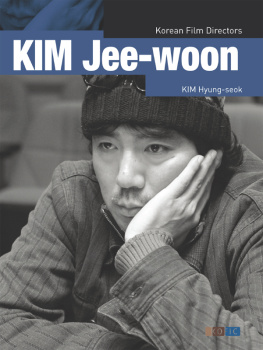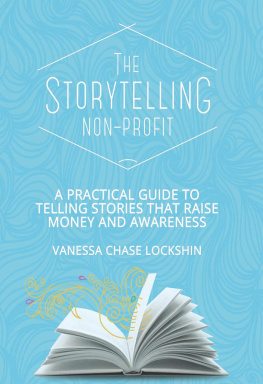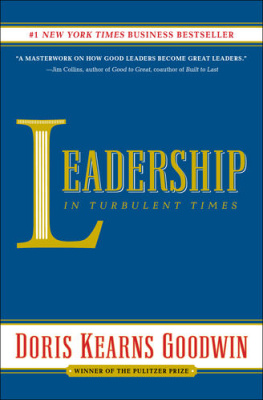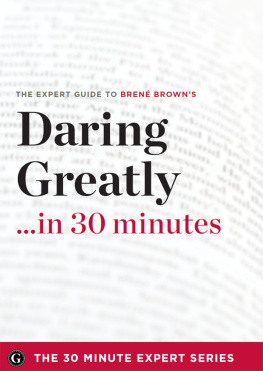Bren Simson - Storytelling for Directors
Here you can read online Bren Simson - Storytelling for Directors full text of the book (entire story) in english for free. Download pdf and epub, get meaning, cover and reviews about this ebook. publisher: Crowood, genre: Detective and thriller. Description of the work, (preface) as well as reviews are available. Best literature library LitArk.com created for fans of good reading and offers a wide selection of genres:
Romance novel
Science fiction
Adventure
Detective
Science
History
Home and family
Prose
Art
Politics
Computer
Non-fiction
Religion
Business
Children
Humor
Choose a favorite category and find really read worthwhile books. Enjoy immersion in the world of imagination, feel the emotions of the characters or learn something new for yourself, make an fascinating discovery.
- Book:Storytelling for Directors
- Author:
- Publisher:Crowood
- Genre:
- Rating:4 / 5
- Favourites:Add to favourites
- Your mark:
- 80
- 1
- 2
- 3
- 4
- 5
Storytelling for Directors: summary, description and annotation
We offer to read an annotation, description, summary or preface (depends on what the author of the book "Storytelling for Directors" wrote himself). If you haven't found the necessary information about the book — write in the comments, we will try to find it.
Storytelling for Directors — read online for free the complete book (whole text) full work
Below is the text of the book, divided by pages. System saving the place of the last page read, allows you to conveniently read the book "Storytelling for Directors" online for free, without having to search again every time where you left off. Put a bookmark, and you can go to the page where you finished reading at any time.
Font size:
Interval:
Bookmark:

STORYTELLING
FOR DIRECTORS
FROM SCRIPT TO SCREEN
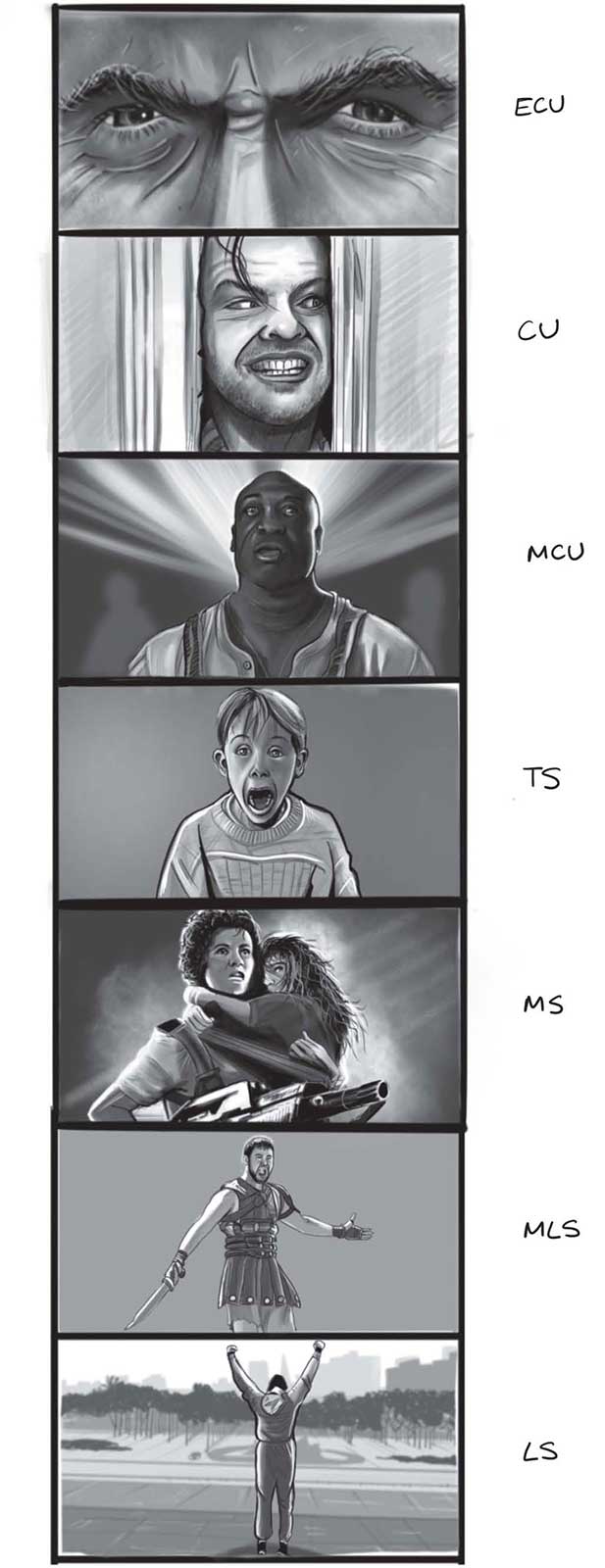
STORYTELLING
FOR DIRECTORS
FROM SCRIPT TO SCREEN
BREN SIMSON

First published in 2020 by
The Crowood Press Ltd
Ramsbury, Marlborough
Wiltshire SN8 2HR
This e-book first published in 2020
www.crowood.com
Bren Simson 2020
All rights reserved. This e-book is copyright material and must not be copied, reproduced, transferred, distributed, leased, licensed or publicly performed or used in any way except as specifically permitted in writing by the publishers, as allowed under the terms and conditions under which it was purchased or as strictly permitted by applicable copyright law. Any unauthorised distribution or use of this text may be a direct infringement of the authors and publishers rights, and those responsible may be liable in law accordingly.
British Library Cataloguing-in-Publication Data
A catalogue record for this book is available from the British Library.
ISBN 978 1 78500 730 9
ACKNOWLEDGEMENTS
Very special thanks go to Maximilian Mena, who designed the storyboards and illustrations for Storytelling for Directors: From Script to Screen. He is a recent graduate in film-making from the Arts University, Bournemouth, and I am hugely in his debt.
My thanks also go to a very special group of people who, over the years I have been teaching, gave me support and encouragement. Neil Peplow and Joe Hepworth were my colleagues at the MetFilm School, who started me on the journey that led to writing this book. Others to whom I owe a special debt of thanks are Faye, Tim Mercier, Jonathan Fryer, Ronan Sweeney and Darren Paul Fisher.
At the Film School in the Arts University, Bournemouth, among my many sympathetic and supportive colleagues, I would like to thank Jonathan Carr, Mark Sheldon, Tom Strudwick and David OShea.
A special mention goes to my dear friend, Martin Hawkins, who was my Director of Photography on Island, ITV (I99596), who kindly supplied photographs for this book.
I am profoundly grateful to Nigel Walsh, who gave generously of his time to read through the manuscript. His advice on all matters of style was invaluable.
Finally, my most heartfelt thanks go to my son, Jack Simson Caird, without whose love and support, I could never have contemplated starting, let alone finishing, this book. To my granddaughters, Rosa and Charlotte, who bring me constant joy.
INTRODUCTION
In writing Storytelling for Directors: From Script to Screen, my aim is to provide a guide for anyone wanting to direct, whether in short films, feature films or small-screen drama.
Rather than being prescriptive about how to direct, the idea is to take the reader through the process of translating a written story into a visual medium. Starting with interpreting the screenplay, to figuring out how the drama will work visually, each chapter helps you to build the communicative power of your storytelling.
Exploring how to tell the story through performance, as well as through the camera, the book takes you through the complex decision-making needed to build the visual world of the story. Storytelling is essentially a collaborative art, so having a creative vision that empowers every department of film-making to do their best for the story is every directors aim.
I have drawn on my twenty-five plus years as a television director, together with my experience teaching film-making, to give an in-depth understanding of the demands and complexities of being a director.
Leaving film school, beginning my first directing job, it felt as though I was stepping into uncharted territory. Despite being taught by some inspirational teachers, I learnt my craft by making films. Learning by doing was the mantra of The National Film and Television School under its founder Colin Young. Although I was lucky enough to keep learning by working in series television at a time when audiences rarely dipped below 10 million viewers, I was aware that sometimes my understanding of the job fell short of the expectations that were increasingly being put upon it.
My aim for this book is to try to remedy those deficiencies, which were entirely of my own making, by sharing my insights into a job I loved doing. Drawing on the work and experiences of other directors and teachers, as well as my own, I try to find the answers to some of the leading questions about visual storytelling.
As directors, everything we do requires action: interpreting, choosing, shaping performance, designing shots. However, finding the right action requires thought. Without a creative vision, you are just a traffic lights director green for action, red for cut.
The challenges of mastering linear narrative forms, as well as inventing new story structures, which work for new technologies and distribution systems, can be confusing. I hope Storytelling for Directors goes some way to helping to generate new ideas, memorable characters and, above all, stories that help to make the world a more interesting and meaningful place.
In the dark times.
Will there also be singing?
Yes, there will also be singing.
About the dark times.
Bertolt Brecht,
Motto to the Svendborg Poems
[Motto der Svendborger Gedichte] (1939), trans.
John Willett in Poems, 19131956, p. 320.
WHAT IS THE STORY?
A screenplay is a visual story in written form. The job of a director is to transform the words on the page into a series of moving images. The first steps in this process of transformation take place as the director starts to interpret and re-imagine the screenplay as a visual narrative.
Storytelling in a visual medium relies, above all, on action and movement, rather than dialogue; which is not to say words are not important, but it is the emotion that lies behind them that counts. A screenplay uses minimal dialogue, relying instead on the dramatic event, the physical movement of the characters, together with their unspoken emotions, to convey the storys meaning.
The first task is to read the screenplay. The emotional impression the story makes on this first reading is an important guide to the film you will make and the responses you want to inspire in the audience. Even if you are the screenwriter, it is important, when starting a production, to try to read the script afresh, re-imagining it as a visual story.
The first reading is when you allow yourself to experience the story unfiltered by anything other than curiosity. Letting it wash over you, leaving an overall impression of the story. Remembering your initial response to the story will come in useful in the coming weeks, as you start to break down the screenplay into its component parts.
After the first reading comes the second, the third and so on, until you feel comfortable with the task ahead. This process of engaging intensively with the material is all about deciding how the story will work dramatically. For the writer director, it is about finding the most compelling way of turning your original idea into drama.
Font size:
Interval:
Bookmark:
Similar books «Storytelling for Directors»
Look at similar books to Storytelling for Directors. We have selected literature similar in name and meaning in the hope of providing readers with more options to find new, interesting, not yet read works.
Discussion, reviews of the book Storytelling for Directors and just readers' own opinions. Leave your comments, write what you think about the work, its meaning or the main characters. Specify what exactly you liked and what you didn't like, and why you think so.

